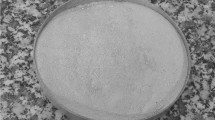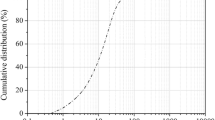Abstract
Ground granulated blast-furnace slag (GGBS), activated with olivine (Mg2SiO4) and sodium hydroxide (NaOH), was used to stabilise a clayey soil. Mechanical and microstructural properties of the stabilised soil were assessed through uniaxial compression strength (UCS) tests, X-ray diffraction, scanning electron microscopy and energy-dispersive X-ray spectroscopy (EDS), after curing periods of 7, 18 and 90 days. The UCS of the GGBS-treated soil (without activation with NaOH), even at the highest slag dosage (G20S), after 90 days, showed only a slight increase (142 kPa) relatively to the original soil. When olivine was added to the GGBS-treated mixture (O20G20S), the UCS increased to 444 kPa, after 90 days. However, when NaOH was used as an activator, the UCS of the olivine–GGBS-treated soil (NO20G20S) increased to more than 6000 kPa, after 90 days. This significant strength increase was attributed to the higher reaction degree provided by the NaOH, which enabled a more effective exploitation (dissolution) of the Ca and Mg present in the slag and olivine, respectively, forming a mixture of C–S–H and M–S–H gels.









Similar content being viewed by others
References
Al-Tabbaa A, Liu C, Gao L et al (2015) Incorporation of reactive magnesia and quicklime in sustainable binders for soil stabilisation. Eng Geol 195:53–62. https://doi.org/10.1016/j.enggeo.2015.05.025
ASTM D2487-11 (2011) Standard practice for classification of soils for engineering purposes (Unified Soil Classification System). Am Soc Test Mater
Ball RJ, Pourakbar S, Huat BK et al (2016) Utilisation of carbonating olivine for sustainable soil stabilisation. Environ Geotech 4:184–198. https://doi.org/10.1680/jenge.15.00018
BSi 1377–4 (1990) BS 1377-4: 1990 - Methods of test for soils for civil engineering purposes, Part 4: Compaction-Related Tests. Br Stand Institution, London, p 4
BSi 1377–7 (1990) BS 1377-7: 1990 - Methods of test for soils for civil engineering purposes, Part 7: Shear Strength Tests (Total Stress). Br Stand Institution, London, p 7
Chang I, Cho GC (2019) Shear strength behavior and parameters of microbial gellan gum-treated soils: from sand to clay. Acta Geotech 14:361–375
Cheng L, Shahin MA, Chu J (2019) Soil bio-cementation using a new one-phase low-pH injection method. Acta Geotech 14:615–626
Du YJ, Wu J, Bo YL, Jiang NJ (2019) Effects of acid rain on physical, mechanical and chemical properties of GGBS–MgO-solidified/stabilized Pb-contaminated clayey soil. Acta Geotech. https://doi.org/10.1007/s11440-019-00793-y
Fasihnikoutalab MH, Asadi A, Kim Huat B et al (2016) Laboratory-scale model of carbon dioxide deposition for soil stabilisation. J Rock Mech Geotech Eng 8:178–186. https://doi.org/10.1016/j.jrmge.2015.11.001
Fasihnikoutalab MH, Pourakbar S, Ball RJ, Huat BK (2017) The effect of olivine content and curing time on the strength of treated soil in presence of potassium hydroxide. Int J Geosynth Gr Eng 3:12. https://doi.org/10.1007/s40891-017-0089-3
Gartner E (2004) Industrially interesting approaches to “low-CO2” cements. Cem Concr Res 34:1489–1498. https://doi.org/10.1016/j.cemconres.2004.01.021
Haha MB, Lothenbach B, Le Saout G, Winnefeld F (2011) Influence of slag chemistry on the hydration of alkali-activated blast-furnace slag—Part I: effect of MgO. Cem Concr Res 41:955–963. https://doi.org/10.1016/J.CEMCONRES.2011.05.002
Higgins DD, Kinuthia JM, Wild S (1998) Soil stabilization using lime-activated ground granulated blast furnace slag. Spec Publ 178:1057–1074. https://doi.org/10.14359/6023
Horpibulsuk S, Bergado DT, Lorenzo GA (2004) Compressibility of cement-admixed clays at high water content. Géotechnique 54:151–154. https://doi.org/10.1680/geot.54.2.151.36341
Horpibulsuk S, Miura N, Nagaraj TS (2004) Assessment of strength development in cement-admixed high water content clays with Abrams’ law as a basis. Géotechnique 53:439–444. https://doi.org/10.1680/geot.53.4.439.37319
Huat BK, Ball RJ, Asadi A et al (2017) Utilization of alkali-activated olivine in soil stabilization and the effect of carbonation on unconfined compressive strength and microstructure. J Mater Civ Eng 29:06017002. https://doi.org/10.1061/(asce)mt.1943-5533.0001833
Jegandan S, Liska M, Osman AA-M, Al-Tabbaa A (2010) Sustainable binders for soil stabilisation. Proc Inst Civ Eng—Gr Improv 163:53–61. https://doi.org/10.1680/grim.2010.163.1.53
Kim Y, Worrell E (2002) CO2 emission trends in the cement industry: an international comparison. Mitig Adapt Strateg Glob Change 7:115–133. https://doi.org/10.1023/A:1022857829028
Konsta-Gdoutos MS, Shah SP (2003) Hydration and properties of novel blended cements based on cement kiln dust and blast furnace slag. Cem Concr Res 33:1269–1276. https://doi.org/10.1016/S0008-8846(03)00061-9
Lothenbach B, Scrivener K, Hooton RD (2011) Supplementary cementitious materials. Cem Concr Res 41:1244–1256. https://doi.org/10.1016/j.cemconres.2010.12.001
Nidzam RM, Kinuthia JM (2010) Sustainable soil stabilisation with blastfurnace slag—a review. Proc Inst Civ Eng—Constr Mater 163:157–165. https://doi.org/10.1680/coma.2010.163.3.157
Obuzor GN, Kinuthia JM, Robinson RB (2011) Enhancing the durability of flooded low-capacity soils by utilizing lime-activated ground granulated blastfurnace slag (GGBS). Eng Geol 123:179–186. https://doi.org/10.1016/j.enggeo.2011.07.009
Obuzor GN, Kinuthia JM, Robinson RB (2012) Soil stabilisation with lime-activated-GGBS-A mitigation to flooding effects on road structural layers/embankments constructed on floodplains. Eng Geol 151:112–119. https://doi.org/10.1016/j.enggeo.2012.09.010
Porbaha A (1998) State of the art in deep mixing technology: part I. Basic concepts and overview. Proc Inst Civ Eng—Gr Improv 2:81–92. https://doi.org/10.1680/gi.1998.020204
Pourakbar S, Asadi A, Huat BBK, Fasihnikoutalab MH (2015) Stabilization of clayey soil using ultrafine palm oil fuel ash (POFA) and cement. Transp Geotech 3:24–35. https://doi.org/10.1016/j.trgeo.2015.01.002
Provis JL (2014) Geopolymers and other alkali activated materials: why, how, and what? Mater Struct Constr 47:11–25
Richardson IG, Brough AR, Groves GW, Dobson CM (1994) The characterization of hardened alkali-activated blast-furnace slag pastes and the nature of the calcium silicate hydrate (C-S-H) phase. Cem Concr Res 24:813–829. https://doi.org/10.1016/0008-8846(94)90002-7
Riemer P, Hendriks C, Ozawa Meida L et al (2007) Emission reduction of greenhouse gases from the cement industry. Greenhouse Gas Control Technol 4:939–944
Shi C, Day RL (1993) Chemical activation of blended cements made with lime and natural pozzolans. Cem Concr Res 23:1389–1396. https://doi.org/10.1016/0008-8846(93)90076-L
Wang X, Tao J (2019) Polymer-modified microbially induced carbonate precipitation for one-shot targeted and localized soil improvement. Acta Geotech 14:657–671
Wild S, Kinuthia JM, Jones GI, Higgins DD (1998) Effects of partial substitution of lime with ground granulated blast furnace slag (GGBS) on the strength properties of lime-stabilised sulphate-bearing clay soils. Eng Geol 51:37–53. https://doi.org/10.1016/S0013-7952(98)00039-8
Wild S, Kinuthia JM, Robinson RB, Humphreys I (2006) Effects of ground granulated blast furnace slag (GGBS) on the strength and swelling properties of lime-stabilized kaolinite in the presence of sulphates. Clay Miner 31:423–433. https://doi.org/10.1180/claymin.1996.031.3.12
Wu C, Chu J, Wu S et al (2019) Microbially induced calcite precipitation along a circular flow channel under a constant flow condition. Acta Geotech 14:673–683
Yi Y, Liska M, Al-Tabbaa A (2013) Properties and microstructure of GGBS–magnesia pastes. Adv Cem Res 26:114–122. https://doi.org/10.1680/adcr.13.00005
Yi Y, Li C, Liu S, Al-Tabbaa a A (2014) Resistance of MgO–GGBS and CS–GGBS stabilised marine soft clays to sodium sulfate attack. Géotechnique 64:673–679. https://doi.org/10.1680/geot.14.t.012
Yi Y, Liska M, Al-Tabbaa A (2014) Properties of two model soils stabilized with different blends and contents of GGBS, MgO, lime, and PC. J Mater Civ Eng 26:267–274
Yi Y, Gu L, Liu S, Puppala AJ (2015) Carbide slag–activated ground granulated blastfurnace slag for soft clay stabilization. Can Geotech J 52:656–663
Yi Y, Zheng X, Liu S, Al-Tabbaa A (2015) Comparison of reactive magnesia- and carbide slag-activated ground granulated blastfurnace slag and Portland cement for stabilisation of a natural soil. Appl Clay Sci 111:21–26. https://doi.org/10.1016/j.clay.2015.03.023
Yi Y, Gu L, Liu S (2015) Microstructural and mechanical properties of marine soft clay stabilized by lime-activated ground granulated blastfurnace slag. Appl Clay Sci 103:71–76
Author information
Authors and Affiliations
Corresponding author
Additional information
Publisher's Note
Springer Nature remains neutral with regard to jurisdictional claims in published maps and institutional affiliations.
Rights and permissions
About this article
Cite this article
Fasihnikoutalab, M.H., Pourakbar, S., Ball, R.J. et al. Sustainable soil stabilisation with ground granulated blast-furnace slag activated by olivine and sodium hydroxide. Acta Geotech. 15, 1981–1991 (2020). https://doi.org/10.1007/s11440-019-00884-w
Received:
Accepted:
Published:
Issue Date:
DOI: https://doi.org/10.1007/s11440-019-00884-w




